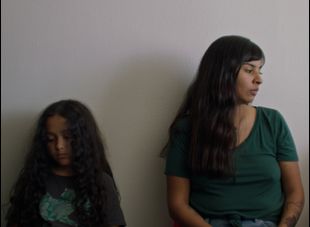“Let him be normal,” a friend says to Elena (Julia Chavez) in “The Other Tom,” looking over at her nine-year-old son Tom (Israel Rodriguez), a rambunctious kid given to pressing all the buttons upon getting into an elevator and doing the opposite of what his mother tells him. Elena can’t afford to have patience, quite literally as a single mother who works to keep a roof over their head, she only has the time to drop him off at school and see him late at night after clocking out, leaving the suggestion of those ostensibly spending more time with him — the teachers at his school — that Tom might have ADHD and could calm down with some prescription medication to take on considerable weight. However, while her son’s behavior may become more palatable for adults, the ever-increasing medication seems to be taking a toll on him in Rodrigo Plá and Laura Santullo’s compelling drama.
After their international breakthrough “A Monster With a Thousand Heads,” detailing a woman’s struggle to get her husband’s insurance claims honored, the Uruguayan filmmaking duo head to El Paso, Texas for their latest, a tender study of a mother and son who desperately want to see the world through each other’s eyes to figure out what the other needs. While Tom pines for his father Julian, who has moved far away, Elena struggles to do right by him when her initial acceptance of medication becomes an issue with the local child welfare department once she starts having second thoughts, and Plá and Santullo observe with meticulous detail how difficult it is even without Elena’s various obligations to reconcile treatment imposed by general state services and the individual needs of any particular patient.
Using nonprofessional actors and investing nearly a year on the ground before making the film, the co-directors build on a foundation of undeniable authenticity to create a delicate and at times harrowing portrait of a duo who ultimately only have one another to lean on, with their signature use of ultra-wide framing to emphasize an us-against-the-world feel and deftly deploy reflective surfaces to dive a bit deeper into the emotions that could be hiding within. In the midst of traveling the fall festival circuit from a world premiere in Venice to a North American bow in Toronto, “The Other Tom” has become one of the great discoveries and Plá recently took the time to talk about making how he and his longtime partner Santullo went about making their first English-language film, simultaneously conceived as a novel, and letting real life enter the frame.

Laura is a novelist, and each project is different because for example, the last project, she wrote a novel and we made the adaptation. In this case, we started research to write for the film, and while we were writing, she started to write the novel because sometimes, it helps her to better understand the characters because she’s used to writing in first person, so she’s in the head of the characters when she’s writing the novel. So we did it at the same time. We finished first the script and then some things she changed in the novel, and there’s a difference between both things, but we recycle everything.

It was quite interesting to try to approach from this side to the story, and it was like making a new environment. It’s research. It’s learning about all the places. We wanted to make this a story in the United States because there is this thin line between where the state can go into a family business and matters, and [ask ourselves] when is too much and where are the limits between the private and the public when you have a strong state? When does the state have to intervene or not? It all depends and it’s difficult to say and also, who is evaluated?
And several things changed with the research. At the beginning, we wrote in the script that they were taking her to a trial to get the custody of the kid, so she was being in the court for a trial and all that, but after we started to research, we realized that that was too much. We changed that for some kind of judgment, [but instead] it happens when the child protective service goes to her home and make the investigation. It’s very intrusive. It’s very hard. Who will pass this kind of exam? Not my family, for sure, because sometimes we scream too much or sometimes we react in ways that [don’t reflect well]. So we change that and instead of [making the] state like the [big] bad or something like that, we try to find a balance. We decided that the state goes makes the investigation that is quite rude, but at the same time, is trying to negotiate with [the mother] because they doesn’t believe there’s a necessity to take the custody out of her. The investigation that we did gave richness to the story.
Then there were things like reading the Anne Applebaum article about ADHD and [the reason] we decided to [name] the character Tom was because we had a scene, [with] the theater piece with Tom Sawyer because we liked the idea that she said, “If Tom Sawyer would exist in our days, he will be medicated.” We made a scene because of that article especially.
Was it an interesting experience setting up a production in a country that you hadn’t made a film in yet?
Yes, it was quite difficult. We weren’t really on the border — El Paso and Ciudad Juárez are almost the same city with three big walls in between, but of course, going to and making our first English-language film was quite difficult, but at the same time, it was very interesting and it gave us the opportunity to know these people specifically better because we immersed [ourselves] in this American-Mexican community.

We realized that what we have to do first was to find the kid and then the mother. The kid was the most difficult, so in the workshop, we concentrated on kids. We went to libraries and we make free workshops with the kids of El Paso and we got all the kids in those classroom scenes from those workshops. It also helped us to exercise with the brain muscle to direct, how to work, how to improvise. And having found the kid [Israel], then we search for the mother and we tried to find actors who were close to the reality of our characters. All the teachers you see are teachers from a school in El Paso, Texas. All the [Child Protective Services] were CPS — they don’t work anymore as a CPS, but they used to, so they help with us with the dynamics. The doctors are doctors, etc. This make it easier for me. I have to teach them how to be calm in front of the camera, how to concentrate and how to learn dialogue. That was the most difficult part for them, but mostly, they were doing this by themselves.
What sold you on Julia to play the mother?
Julia was very confident. When we saw her, she had a lot of character — she’s a single mother, [with] three different kids with different fathers, and she works as a massage therapist, so she’s very strong. She reacts very well to different stimulus — I could put her anywhere and she can improvise. With Laura and Julia, we changed a lot of dialogue because at the beginning, the relationship between the kid and the mother was in Spanish, but when we found this kid that was amazing and he was American more than Mexican, we had to change everything to English, and my English is a little bit rudimentary, so [Julia] helped with us with those dialogues. We went through the script and it was an amazing process, [where] she changed the dialogue to English with us.

From different things. It all depends on the film. In this case, we don’t like to underline the emotions very much with our language — with music or with close-ups or going forward with the camera. We want to leave it a little bit open. We like to leave the camera still and see what happens in the middle. It’s like a choreography we make with the actors and with Laura. The first shot of the first scene, we try to concentrate the meaning of the film and what is it about. [In this film] the first reflection, there are two Toms in the frame because it’s the Tom who is not medicated and the medicated Tom. That shot was very important for us because we see two Toms and we see long hair. We don’t know exactly if it’s a he or a she. He can’t stay still. He’s playing like a kid, but his mother is worried about other things and doesn’t tolerate what he’s doing with the buttons [on the elevator] very well, so it’s a little bit what’s going to happen all the way through the movie.
Leaving the camera a little bit still also allows us to leave several things outside of the frame. When we film, we try to concentrate on one or two points of view. In this case, it was two points of view — her point of view and his — and if they are not in the scene, the scene doesn’t exist. We just have scenes where those two are there, so for us to have the point of view of each one, it’s not just what they are looking at. It’s how they are reacting to things, so the camera stays with my actor and actress, and the other ones, I don’t need to see them. I can hear them and we make the frame bigger, like with the bureaucrat at the beginning. He was amazing. He had an amazing face. He did [his part] very well, but we didn’t need to see him. I prefer to see [the main actors] and stay with them.
“The Other Tom” will screen once more at the Toronto Film Festival virtually on September 17th at 3 pm EST, available in Canada.




